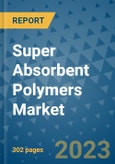Market Insights
Super absorbent polymers, also known as hydrogels, are high-weight polymer chains primarily derived from sodium acrylate, acrylamide, and acrylic acid. Due to their ability to absorb and retain large volumes of liquid relative to their own mass, SAPs are extensively used in disposable diapers, adult incontinence products, feminine hygiene products, and increasingly in agricultural applications.Synthetic SAPs, especially sodium polyacrylate and polyacrylamide copolymers, dominate the market due to their superior liquid retention capabilities. While traditionally non-biodegradable, the shift towards bio-based SAPs is gaining momentum as environmental concerns rise.
Key Market Drivers
One of the most significant drivers of the SAP market is the rising demand for adult incontinence products, particularly in aging populations across developed regions. The increase in the 60+ age demographic in countries like the U.S. and Canada is directly contributing to higher consumption of high-absorbency SAP-based hygiene products.Additionally, the demand for disposable baby diapers remains robust, especially in emerging economies such as India and China, where rising birth rates, increasing disposable incomes, and urbanization trends fuel market expansion.
Another key factor is the performance requirement of SAPs in hygiene products. Products such as adult diapers and feminine hygiene pads require superior absorbency under pressure, further increasing the value and volume demand for SAPs.
Business Opportunity
A major opportunity lies in the development and commercialization of bio-based super absorbent polymers. With growing regulatory scrutiny and environmental norms, manufacturers are investing in sustainable alternatives. Bio-based SAPs, derived from renewable raw materials such as bio-acrylic acid, offer nearly identical performance compared to conventional SAPs and align well with global sustainability goals.Several players are actively working on commercializing such products. For example, investments by companies like Ecovia Renewables and a joint venture between LG Chem and Archer Daniels Midland aim to establish bio-based acrylic acid as a key ingredient in sustainable SAP production.
Regional Analysis
China continues to dominate the East Asian market, with strong consumer demand for personal hygiene products. Factors such as a growing population, rising disposable incomes, and increased awareness about hygiene have accelerated the use of diapers and incontinence products, creating significant demand for SAPs.In India, the market is expanding at a healthy pace due to high birth rates, urbanization, and growing acceptance of hygiene products. Although rural areas exhibit slower adoption, rising awareness campaigns and affordability improvements are expected to boost demand in the long run.
In developed regions such as North America and Europe, the demand is primarily driven by an aging population and the widespread usage of adult incontinence and feminine hygiene products. Manufacturers are also setting up localized production units in these regions to reduce costs and improve supply chain efficiencies.
Competitive Analysis
The global SAP market is highly consolidated, with top manufacturers such as BASF SE, Nippon Shokubai, and Evonik Industries collectively accounting for a significant share of global output. These players focus on expanding production capacities and developing innovative solutions such as ultra-thin and high-absorbency SAPs to stay competitive.Recent strategic developments include:
- Evonik Industries launched its FAVOR®max line designed for thinner and more absorbent diapers.
- Nippon Shokubai expanded its European production facility to meet growing demand.
- LG Chem partnered with ADM to explore bio-based SAP production pathways.
Market Segmentation
By Product Type:
- Sodium Polyacrylate
- Polyacrylamide Copolymer
- Others
By Application:
- Disposable Diapers
- Adult Incontinence Products
- Feminine Hygiene Products
- Agriculture Products
- Others
By Region:
- North America
- Latin America
- Europe
- East Asia
- South Asia & Pacific
- Middle East & Africa
This product will be delivered within 1-3 business days.
Table of Contents
Companies Mentioned
- Nippon Shokubai Co., Ltd
- Evonik Industries AG
- BASF SE.
- Kao Corporation
- Sumitomo Seika Chemicals Co. Ltd.
- Sanyo Chemicals Industries, Ltd.
- LG Chemicals Ltd
- Yixing Danson Technology
- Zhejiang Weilong Polymer Material Co., Ltd
- Quan Zhou Banglida Technology Industry Co., Ltd.
- Shandong Nuoer Biological Technology Co., Ltd.
- Wanhua Chemical Group Co., Ltd
- Sinofloc Chemical Ltd.
- SNF (U.K.) Limited
- Formosa Plastic Corporation
- Songwon Industrial Co. Ltd.








